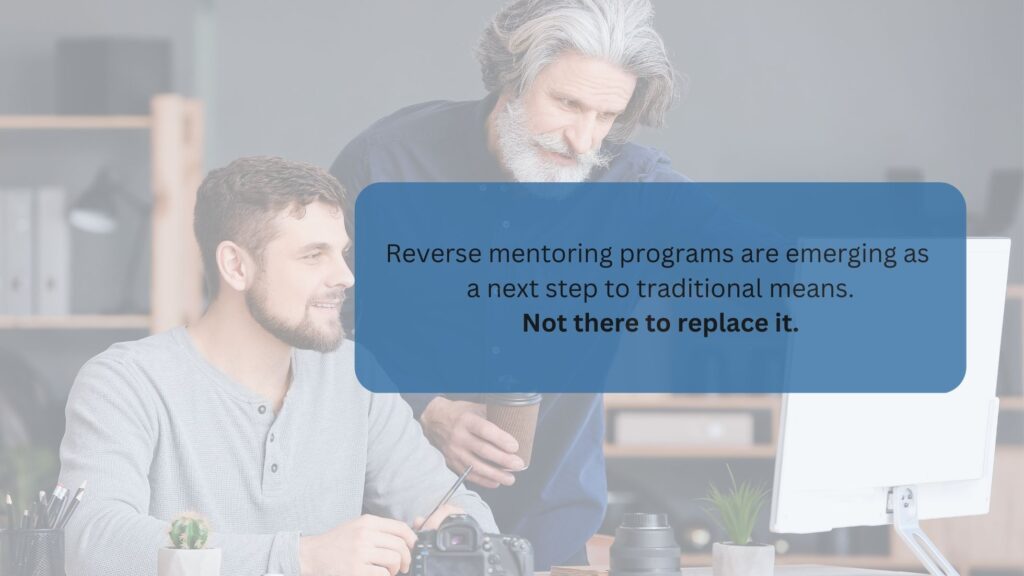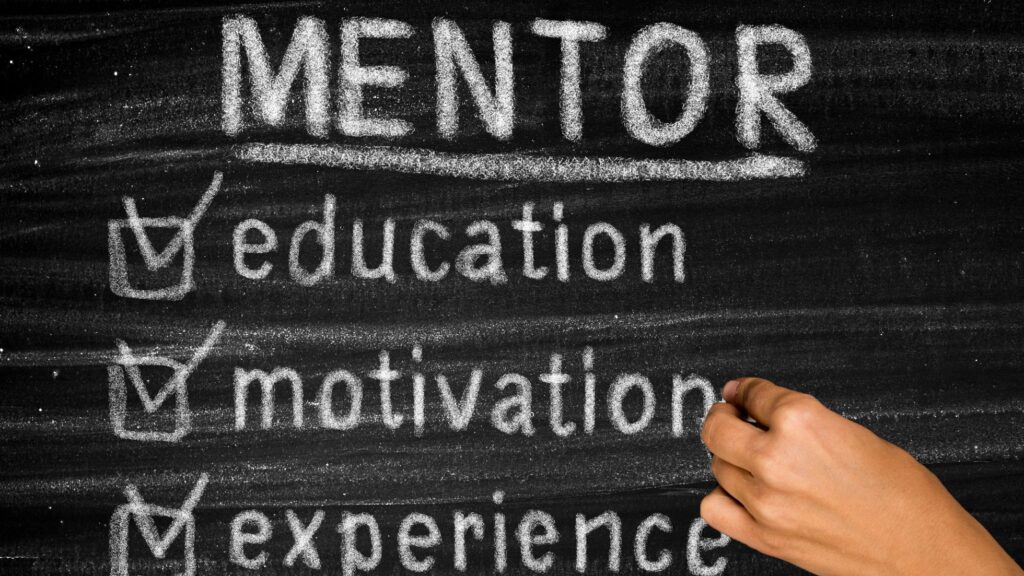
In the fast-paced world of work, reverse mentoring has emerged as a game-changer. Unlike traditional mentorship models, it flips the script, pairing seasoned professionals with their younger counterparts. This creates a dynamic exchange of insights and skills, redefining how knowledge is shared. In this guide, we’ll delve into the principles of reverse mentoring, uncover its benefits, and explore how it’s reshaping workplace dynamics. Get ready to discover how this innovative approach is breaking down generational barriers and fostering a culture of continuous learning and collaboration.
What is Reverse Mentoring and How It Works?
Seasoned leaders always have heaps of wisdom to share with youngsters. But guess what? Even those bright-eyed newcomers also have some savvy insights to offer. Enter ‘reverse mentoring,’ a concept hatched in the ’90s to exchange tech-savvy know-how from young employees to the more senior staff.
Now, post-pandemic, this unique approach can serve as the springboard to tackle the fresh hurdles of blended workforces, thereby fostering inclusivity and debunking stereotypes rooted in generational gaps.
To understand this concept better, imagine flipping the paradigm of typical mentorship. Rather than experienced pros directing their junior counterparts, it’s the new-age workforce who would enlighten the management on hot and trendy work-related topics. This would be on anything from customer cravings to reel trends to some tech or work fad that is evolving fast. Sounds exciting! We shall discuss this implementation up close in the later section.
Also Read: Six Ways to Use Reverse Mentoring
Can Reverse Mentoring Replace Traditional Mentoring?

It possesses an assortment of charismatic reasons to become a choosable factor for corporations. It bridges the age divide, enabling both sides to absorb knowledge from each other’s distinctive experiences and forte.
In such a learning partnership, the seasoned individual often uncovers valuable wisdom, enabling them to work more effectively. It also aids them in collaborating with their peers and direct reports who share similar backgrounds. Hand-in-hand, they stride toward collaborative victories over tons of challenges.
Younger employees get the chance to share their unique skills. By doing so, seniors can adapt to new or fresh mindsets, contributing to the company’s success.
An egalitarian environment emerges in a work environment where expertise takes precedence over egos because diverse ideas are being shared regardless of status.
A multifaceted learning culture is appreciated where collaboration and knowledge sharing are highly important. Elaborately put, it continuously effectuates impartial transformation by efficiently harnessing the potential of the newbies.
Workplace culture morphs into a tightly knit fabric sewed together by threads from a multi-generational workforce. This empowers team members to foster a more dynamic workspace where embracing and valuing individuals of diverse backgrounds with respect and understanding takes center stage.
Reverse Mentoring Implementation
In the dynamic world of professional advancement, traditional mentoring has ruled the roost for sharing wisdom and fostering growth. Visualize seasoned executives guiding young newbies through the sophistication of corporate life in a wise and measured manner. This is a typical implementation of traditional mentoring; reverse mentoring, however, as aforementioned, flips this age-old model on its head like an unexpected plot twist in a riveting novel. There are more ways reverse mentoring can be implemented, as explained below!
1. Tech Knowledge Upgradation
In the swiftly progressing world, senior or aged professionals often find it tough to stay in sync with the latest advancements. Thus, they may require that extra touch of guidance and the necessary support to adapt seamlessly to this constantly transforming landscape. Furthermore, this situation highlights the importance of acknowledging their challenges, thereby setting the stage for smooth transitions in the rapidly evolving world.
Introducing reverse mentoring, where fresh-faced newcomers offer their fluency in all technological aspects or digital tools. These tech-savvy individuals can assist veterans in getting acclimatized to new technological entities or concepts. It’s akin to spirited explorers navigating unfamiliar waters with the help of knowledgeable locals.
For instance, imagine a casual Friday afternoon meeting, where a Millennial shares different social media marketing techniques with her older colleague – with decades of traditional advertising experience.
This collaboration presents mutual benefits arising from the sharing of ideas. The young employee gains valuable knowledge and recognition in different aspects of the business, while the seasoned professional walks away with newfound social media prowess.
2. Moving Beyond Digital Space
Reverse mentoring is typically associated with technology-based idea sharing and learning. But it transcends the digital landscape, extending its arm to various other facets of the professional world.
One such example: In the complications associated with modern office culture, juniors can share their individual perspectives on building a collaborative and innovative environment.
Picture this: A workplace where Thursdays become idea-sharing days; consequence – the boardroom transforms into a brainstorming haven.
Consider two coworkers sipping their favorite caffeinated beverages at their office pantry. They engage in spirited discussions about industry trends, comparing each other’s viewpoints.
This type of relaxed environment where idea exchange takes place epitomizes the casual atmosphere associated with reverse mentoring relationships. Importantly, it avoids any pretentious air that may accompany traditional mentoring dynamics. Because both parties are looking to grow together, a harmonious connection replaces the strain of strict adherence to rigidly defined roles.
Another instance could be initiating conversations with younger generations to gain unique insights into their values and perspectives. Turning to minority groups within the broader workforce can help identify improvements needed for a more inclusive environment.
For instance, the UK division of consultancy firm PwC utilized reverse mentoring as a strategy to promote diversity and inclusion. They paired junior and senior employees not only based on generational gaps but also with considerations for gender and ethnicity differences.
Similarly, law firm Linklaters employed this approach to educate their leadership team on LGBTQ+ issues and matters based on social mobility.
Traditional and Modern Mentoring
These real-life instances showcase the efficacy of reverse mentoring initiatives in fostering open dialogue and understanding among varied groups.
Simply put, reverse mentoring stresses mutual respect and acknowledges that insight—be it knowledge sharing or learning—is bidirectional. Hierarchy primacy doesn’t always matter, and the highlighting feature is more about colleagues coming together as equals to learn from one another.
Fundamentally, the distinction between conventional and reverse mentorship not only revolves around the method of wisdom sharing but also the fundamental ideology behind it.
Reverse mentoring proves that wisdom is not tethered to age or experience but to the willingness to adapt and learn. And this can rejuvenate any professional’s repertoire. Like a cool breeze on a warm summer’s day, it brings delight and ingenuity to the timeless process of development.
Also Read: What Reverse Mentoring Can Do for Your Organization
Benefits of Reverse Mentoring

Regarding the unique qualities of reverse mentoring, how can one simply not ignore the delightful melting pot of fresh perspectives and seasoned experiences it caters to? Here are some more:
Rekindling the Passion for Learning: The most invigorating advantage has to be how these youthful staffers are still their more seasoned colleagues with a revitalized passion for learning. This also amps up their confidence, ensuring them that their voices will indeed be acknowledged.
Consider a scenario: A tech-savvy teenager introduces senior staff to the endless possibilities offered by virtual collaboration platforms.
Level Playing Field
Another intriguing virtue of reverse mentoring is its ability to promote equality within establishments. The era was over when stoic hierarchies reigned supreme forever. This modern twist of reverse mentoring triggers playful teamwork and a fusion of thoughts, sparking altogether new ideas like never seen before.
Consider this case: A keen-eyed junior specialist dazzles their awed mentor with a creative cost-cutting solution.
Bridge Generational Gaps
Needless to say, no discussion about reverse mentoring is complete without addressing its intrinsic tendency to bridge generational gaps. Thanks to reverse mentoring, step into the world where age-old wisdom and millennial swagger coexist in harmonious unison.
Visualize this scenario: A novice and seasoned expert from vastly separate roots share a casual yet stimulating coffee chat, engaging in light-hearted banter about their cherished principles and ambitious dreams.
It’s in this non-procedural environment or relaxed atmosphere that barriers crumble and true camaraderie can bloom – facilitating a professional bond destined to yield bountiful intellectual fruit.
Individual Pride and Humbleness
Lastly, the subtle yet significant benefit of reverse mentoring is its impact on individual pride and humbleness – after all, legacy is challenged. Interestingly, as tenured team members graciously accept the suggestions or tips of considerably less experience, a culture of open-mindedness and mutual respect emerges. Likewise, the younger mentors learn to navigate the nuanced boundaries of professional decorum with grace and discretion.
Conclusion
In conclusion, the art of reverse mentoring has emerged as a powerful and innovative approach to learning and collaboration in the professional world. By flipping traditional mentorship dynamics, where experienced individuals guide those less seasoned, reverse mentoring brings fresh perspectives, new technologies, and contemporary insights to the forefront.
Mentoring Complete – a platform that enables all forms of mentoring can be used to conduct reverse mentoring in your organization. So unlock the potential of juniors and let seniors benefit from it. Start your reverse mentoring journey now! Need help?
Frequently Asked Questions
Q. Why is reverse mentoring important?
Reverse mentoring focuses on sharing ideas or knowledge from a new angle, bridging generational gaps, and facilitating mutual understanding between seniors and juniors.
Q. What are the various advantageous reverse mentoring offers?
Some advantages of reverse mentoring include getting rid of stereotypes, nurturing candid dialogue, bolstering personal development, and refining leadership prowess and managerial expertise.
Q. Can reverse mentoring be applied to any workplace or industry?
Yes, reverse mentoring can be implemented in various workplace settings and industries. It would facilitate innovation and improve intergenerational collaboration.
Q. How can organizations incorporate reverse mentoring programs properly?
To establish reverse mentoring, determine specific objectives, establish expectations for both mentors and mentees, provide necessary training, and support open dialogues for continuous learning.
Subscribe To The Mentoring Complete Newsletter